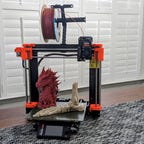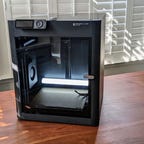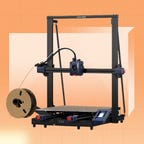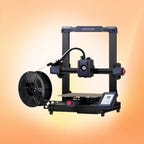Best 3D Printer for 2024
We've tested and reviewed several models to find the top 3D printers, including options from Prusa, Anycubic, Elegoo, Bambu Lab and more.
What to consider
What material type do you need?
How big do you want to print?
What's your budget?
Our Picks
3D printing has really taken off in recent years. It used to be limited to tinkerers and hobbyists, but it has become a full ecosystem that is much easier to enter. There are a ton of 3D printers out there today, but the best ones are quick and accurate, and some can print in multiple colors or materials.
With so many options to choose from, picking the best 3D printer for you can be difficult. After spending hundreds of hours printing on a wide range of machines, we've put together this list. Our recommendations include options across several categories. Whether you want a resin 3D printer to make miniatures for your Dungeons and Dragons game, or a large-format printer to make cosplay armor, we have the right 3D printer for you.
Which is the best 3D printer?
I've almost a decade and countless hours testing 3D printers in as many ways as possible to bring you the best 3D printers in every class. Right now, the Bambu Lab A1 Combo is our front-runner: It's fast, can produce excellent detail, and it's well-priced at $559. It also comes with an excellent color system so you can print in four different colors.
These models by Fotis Mint are extremely detailed.
This list includes both small and large 3D printers, with attention paid to print speed, the size of the build plate, the cost of materials, the kind of print head included and other important details. Once you've decided to take the plunge into additive manufacturing -- that's what 3D printing essentially is -- there's also an FAQ below.
Best 3D printers of 2024
I rarely find a product that impresses me, like the A1 Combo. The 3D printer is excellent, with fast, quality printing at a great price. Adding the AMS lite elevates the best printer you can buy right now. Four-color printing for less than $600 is such a good price I'm still shocked the company can manage it.
The A1 creates a lot of waste when printing in color, but that is not a good reason not to buy this machine. Whether it is your first printer or another one for your collection, the A1 Combo is the number one printer to buy right now.
Read more: A1 Combo review
Best 3D printer for quality
Prusa MK4
No best 3D printer list is complete without the Prusa MK4. Prusa has dominated the market for nearly a decade, and the MK4 continues the trend of excellent quality and customer care while maintaining high standards in open source.
It is fast, although not the fastest, and always creates quality prints. I can count the number of print fails from MK4 on one finger, and I have been using it for months now. If you have the money, the MK4 is well worth the investment.
Read more: Prusa MK4 Review
Best enclosed 3D Printer
Bambu Lab P1S
The P1S is an updated version of our previous best 3D printer winner, the P1P. Each of the machine's updates —plastic side panels, glass top and door, camera, part fan and LED light—makes the P1S our number-one pick for an enclosed machine.
The quality of the models and the speed at which it can print them are amazing, and very few printers can do both of those things at anywhere near the same price.
Best 3D printer for big projects
Anycubic Kobra 2 Max
Anycubic's reputation for dead simple printers to use without being prohibitively expensive scales well to its updated Kobra 2 Max, making any large printing job a mostly set-and-forget affair. The sheer size of this machine requires some consideration.
To maintain speed with the massive build plate, this bed-slinger comes with some powerful motors, which caused even the sturdiest table in my workshop to wobble. The gyroscope in the print head helps combat most of this, but if you're printing something especially tall, be prepared for some imperfections. Like any Anycubic printer, the software is nowhere near as sophisticated as its more expensive competitors. As long as you're right with those minor compromises, you'll get a lot of great prints out of this machine.
Best 3D printers for beginners
These 3D printers are excellent for anyone just starting out in 3D printing. Check out our expanded list of the best budget 3D printers for more in this category.
Best budget fast 3D printer
Anycubic Kobra 2
While not as fast as the P1P or the X1C, the Kobra 2 is around the same speed as the AnkerMake M5. It will happily produce prints at 250 millimeters per second, though the best quality seems to be hovering around 150mm/s in my testing. It also comes with a filament runout sensor and bed leveling, which works well.
The big selling point for the Kobra 2 is the price. It has all the advantages of a faster printer with a sub-$300 price tag, which is astonishing. This is my recommendation for any first-time buyer or someone on a budget.
Hyperfast 3D Printer
AnkerMake M5
One of the first consumer 3D printers to break the 250 millimeter-per-second speed barrier, the AnkerMake M5 has recently had a software update to push its speed up to 500mm/s on its ultrafast mode. The M5 uses an AI camera to help you detect issues so you can stop a failing print before you waste a lot of material. The AI is particularly bad, but the camera does give you some fantastic time-lapse videos to share on social media.
Read more: AnkerMake M5 Review
Best budget 3D printer with color
Bambu A1 Mini Combo
The A1 Mini Combo is an almost perfect entry to the world of color 3D printing. It's well-priced, and while the build area is small, the quality of the print -- and the fact you can print in four colors straight out of the box -- is amazing. If you're looking for your first printer and want to try color printing, this is a no-brainer.
Best inexpensive resin 3D printer
Anycubic Photon Mono 2
Resin printers are the next step up in rapid prototyping design technology when you want your printing to look as high quality as possible. Just be warned: The liquid resin is harder to work with, requiring good ventilation and a portable UV light to properly cure.
The Photon Mono 2 is Anycubic's latest upgrade to its popular Mono series and is a solid upgrade to the original. The prints are detailed and the printer's size makes it easy to put safely in your workshop. If you want to get into resin printing, the Mono 2 is a great starting point.
The best resin 3D printer experience right now
Elegoo Saturn 3 Ultra
The Elegoo Saturn 3 is an almost perfect upgrade from its predecessor. It is bigger and more powerful, with better-quality prints than its predecessor. It's fast too, printing models at what feels like twice the speed as normal. I am able to print an entire plate of D&D minis in less than hour, which is just crazy.
It is my No. 1 choice for a midrange resin 3D printer. If you're looking to print serious details or many tiny models, this is simply the best choice.
Best 3D printer for educators
Flashforge Adventurer 5M Pro
The Adventurer 5M and the 5M Pro are two excellent 3D printers from Flashforge. They aren't fancy, and you can see they take heavy influence from the P series from Bambu Lab -- but what they do, they do well, and they do it at an enticing price. A solid CoreXY printer that can print solidly at 300mm/s is not to be sniffed at, and one that's under $300 is well worth your time. I especially like the Flashprint software that allows you to network several printers at the same time effortlessly. Great for schools and small print farms.
Best budget 3D printer for exotic filaments
Qidi Q1 Pro
Qidi has made a lot of good 3D printers over the years -- one of my first printers was a Qidi machine -- but the Q1 Pro is the first to hit the sweet spot of price and performance in such a meaningful way. It has a bi-metal hot end that allows you to print exotic filaments like carbon fiber and nylons and a heated build chamber to support those exotic filaments. Those unique traits on a sub-$500 make it a great starter choice for engineers.
Best for small biz or pro cosplayers
Creality CR-30
A word of warning: The CR-30 is not for the beginners out there. It is a complicated machine, and you will need some 3D-printing knowledge to really get the hang of it. It's also a very different beast, and instead of printing on a static-size build plate, it uses a conveyor belt to create an "endless Z-axis." That lets you print extra-long models or lots of things over and over again.
If you are a cosplayer looking to make weapons or large armor pieces, the CR-30 gives you a lot of room to create. I've managed to print Squall's Gunblade from Final Fantasy VIII as well as the Whisper of the Worm from Destiny 2 (both were printed in two halves and attached together). It's great for small businesses looking to mass-produce small parts, and with just two CR-30s you could create a small empire on Etsy or Shopify.
What to consider before buying a 3D printer
Purchasing your first 3D printer can be nerve-wracking, but we're here to help. There are a few main areas that you should consider when choosing the best 3D printer, and we have them covered here.
Should I wait for a deal to buy a 3D printer?
3D printers are often available throughout the year at a discount price. Special days like Prime Day, Black Friday and Cyber Monday are great occasions to pick yourself up a new machine, but there are still plenty of deals to be had throughout the year. Make sure you stay fluid and choose your 3D printer deal based on the availability of the machine and what your research has told you is the best.
What am I 3D printing?
When deciding on what 3D printer to buy, you first have to know what type of things you want to print. Resin 3D printing is good for highly detailed models such as character busts, dental work or tabletop miniatures. Even jewelry can be made using a resin 3D printer.
For almost every other application, an FDM (aka filament) 3D printer, is likely the best choice. Filament 3D printing is versatile in the types of material you can use and offers much larger build volumes to work on models. Cosplay armor and helmets, practical parts and large-scale models are best printed on an FDM printer.
Read more: What Is 3D Printing?
What is build volume?
Build volume is the amount of space a printer has to produce a model. Often calculated in millimeters cubed, it is the combination of the width, height and depth that your printer's nozzle can reach. This is not always the same as the internal volume of a 3D printer because the wiring and other mechanical parts can get in the way of the nozzle, reducing the area available.
Most FDM printers have a build area of around 220 by 220 by 250mm, although some of the best 3D printers have larger areas, while a few of the best budget 3D printers have smaller ones. I think the 220 by 220mm build plate is a good size for starting out, as it has room for large, practical pieces or several smaller models at once.
How we test 3D printers
Testing 3D printers is an in-depth process. Printers often don't use the same materials, or even the same process to create models. I test SLA, 3D printers that use resin and light to print, and FDM, printers that melt plastic onto a plate. Each has a unique methodology. Core qualifiers I look at include:
- Hardware quality
- Ease of setup
- Bundled software
- Appearance and accuracy of prints
- Repairability
- Company and community support
A key test print, representing the (now old) CNET logo, is used to assess how a printer bridges gaps, creates accurate shapes and deals with overhangs. It even has little towers to help measure how well the 3D printer deals with temperature ranges.
When testing speed we slice the model using the standard slicer the machine is shipped with on its standard settings then compare the real-world duration of the print to the statement completion time on the slicer. 3D printers often use different slicers, and those slicers can vary wildly on what they believe the completion time to be.
We then use PrusaSlicer to determine how much material the print should use and divide that number by the real-world time it took to print to give us a more accurate number for the speed in millimeters per second (mm/s) the printer can run at.
Every build plate is supposed to heat up to a certain temperature so we use the InfiRay thermal imaging camera for Android to check how well they do. We set the build plate to 60 degrees Celsius -- the most used temperature for build plates -- waited 5 minutes for the temperature to stabilize, and then measured it in six separate locations. We then took the average temperature to see how close the 3D printer got to the advertised temperature.
Testing resin requires different criteria so I use the Ameralabs standard test -- printing out a small resin model that looks like a tiny town. This helps determine how accurate the printer is, how it deals with small parts and how well the UV exposure works at different points in the model.
Many other anecdotal test prints, using different 3D models, are also run on each printer to test the longevity of the parts and how well the machine copes with various shapes.
For the other criteria, I researched the company to see how well it responds to support queries from customers and how easy it is to order replacement parts and install them yourself. Kits (printers that come only semi-assembled) are judged by how long and difficult the assembly process is and how clear the instructions are.






